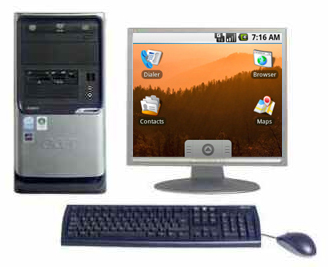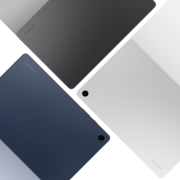 It’s no rumor that Acer is testing Android Netbooks… along with just about everyone else. But what about Android as the operating system for a Desktop PC? Whether or not the idea is a good one and further, if it would gain traction, is an impossible question to answer – but Acer is trying to do just that.
It’s no rumor that Acer is testing Android Netbooks… along with just about everyone else. But what about Android as the operating system for a Desktop PC? Whether or not the idea is a good one and further, if it would gain traction, is an impossible question to answer – but Acer is trying to do just that.
According to Gearlog (via CrunchGear), Acer held a press event last night and mentioned that they already have a prototype Desktop PC running Android! This comes by way of reliable tweet – if there is such a thing – from LanceUlanoff who is also a writer at PCMag.com.
I’m not sure I could envision Android has a standalone OS on a full featured Desktop PC, but who decides what a Desktop PC should and shouldn’t be? Why couldn’t Android be a part of a hybrid Desktop PC that converge a number of existing technologies much in the way the Android Hub hopes to do?
An Engadget article quoted Acer CEO Gianfranco Lanci and Product Manager Jim Wong as saying of their Android Netbook prototype “it has a good chance” of making it to consumers while they were unsure of the Dekstop PC prototype. But since Phandroid readers are the brains of the techworld, you tell us…
How do YOU envision Android working on a Desktop PC environment… if at all?









I was thinking along these lines when the Hub was announced. A phone hub that also works as a media center, that also plays cutting edge games, that also has all the android goodness. There’s no reason it can’t be done.
A tablet pc of course
I think it’s high-time that another Major Tech Player got into the game with a competitve OS. While I think Ubuntu is great, it seems regulated to mediocrity with geeks who like to ‘play’ with things as opposed to a seriously stand-alone OS with a major hardware manufacturer/PC supplier.
Seems to me that what’s needed for Android or any other Linux desktop to succeed in Adobe Creative Suite.
interesting. mmm.
I could see it happening. Most anything could be adapted with enough work. Making the OS isn’t the problem I see. Its getting companies like NVIDIA and ATI on-board to help get their hardware functioning properly on other operating systems besides Windows. Either that or having a company which will create a 3D video card with open source drivers. There have been companies to do this but there needs to be one that has the cash to manufacture the cards and sell them.